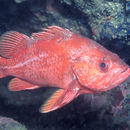en
names in breadcrumbs


Scorpaenoidei is a suborder of ray-finned fishes, part of the order Scorpaeniformes, that includes the scorpionfishes, lionfishes and velvetfishes. This suborder is at its most diverse in the Pacific and Indian Oceans but is also found in the Atlantic Ocean.
Scorpaenoidei was first named as a suborder in 1899 by the American ichthyologist Samuel Garman[2] as a suborder of the Perciformes.[1] Some authorities still treat the suborder as being part of the Perciformes[3] but the 5th Edition of Fishes of the World recognises the Scorpaeniformes as a valid order and places this suborder within it.[4] The subfamilies of the family Scorpaenidae are treated as families by some authors.[3] It has been argued by some authors that the suborder is paraphyletic and that a more correct classification is that the grouping, with some differences, be placed on the superfamily Scorpaenoidea.[5]
The suborder Scorpaenoidei is classified into families and subfamilies in the 5th Edition of Fishes of the World as follows:[4][6]
Suborder Scorpaenoidei
Scorpaenoidei is rather varied grouping of around 470 species of moderately-sized fishes which have 24 to 44 vertebrae and the ribs towards the head are either absent or rigidly attached to the spine.[7]
Scorpaenoidei are found in all the tropical and temperate oceans of the world but most species are found in the Indian and Pacific Oceans. The suborder includes benthic and pelagic species and marine and freshwater species.[4]
Scorpaenoidei contaiuns some of the most venomous fish species known, including lionfishes, stonefishes and scorpionfishes.[4]
Scorpaenoidei is a suborder of ray-finned fishes, part of the order Scorpaeniformes, that includes the scorpionfishes, lionfishes and velvetfishes. This suborder is at its most diverse in the Pacific and Indian Oceans but is also found in the Atlantic Ocean.